Abstract
This article addresses issues related to the characterization of endocrine-related health effects resulting from low-level exposures to polychlorinated biphenyls (PCBs). It is not intended to be a comprehensive review of the literature but reflects workshop discussions. "The Characterizing the Effects of Endocrine Disruptors on Human Health at Environmental Exposure Levels," workshop provided a forum to discuss the methods and data needed to improve risk assessments of endocrine disruptors. This article contains an overview of endocrine-related (estrogen and thyroid system) interactions and other low-dose effects of PCBs. The data set on endocrine effects includes results obtained from mechanistic methods/ and models (receptor based, metabolism based, and transport protein based), as well as from (italic)in vivo(/italic) models, including studies with experimental animals and wildlife species. Other low-dose effects induced by PCBs, such as neurodevelopmental and reproductive effects and endocrine-sensitive tumors, have been evaluated with respect to a possible causative linkage with PCB-induced alterations in endocrine systems. In addition, studies of low-dose exposure and effects in human populations are presented and critically evaluated. A list of conclusions and recommendations is included.
Full text
PDF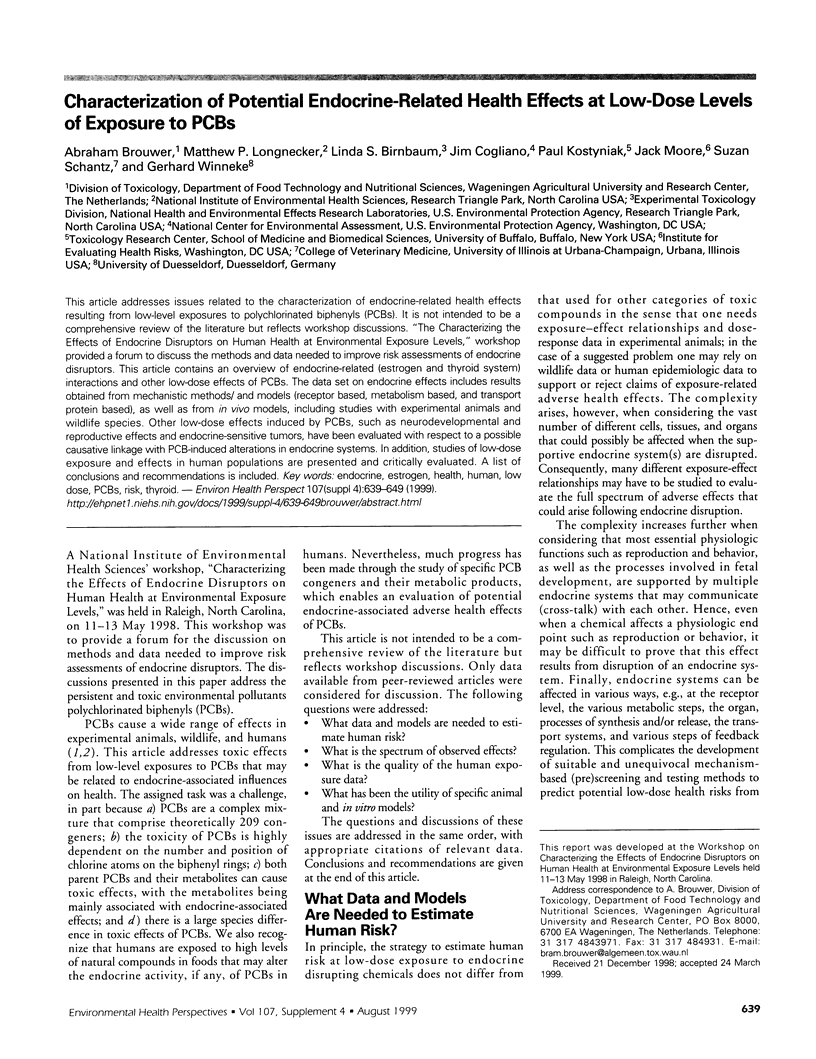

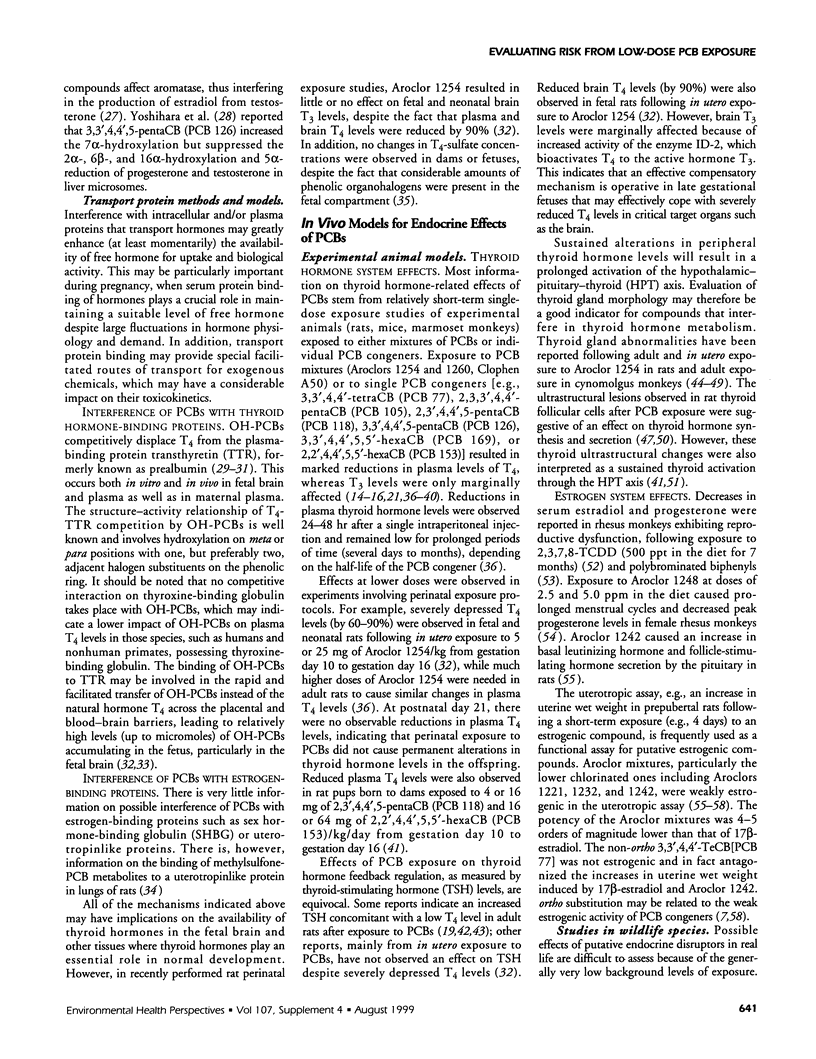
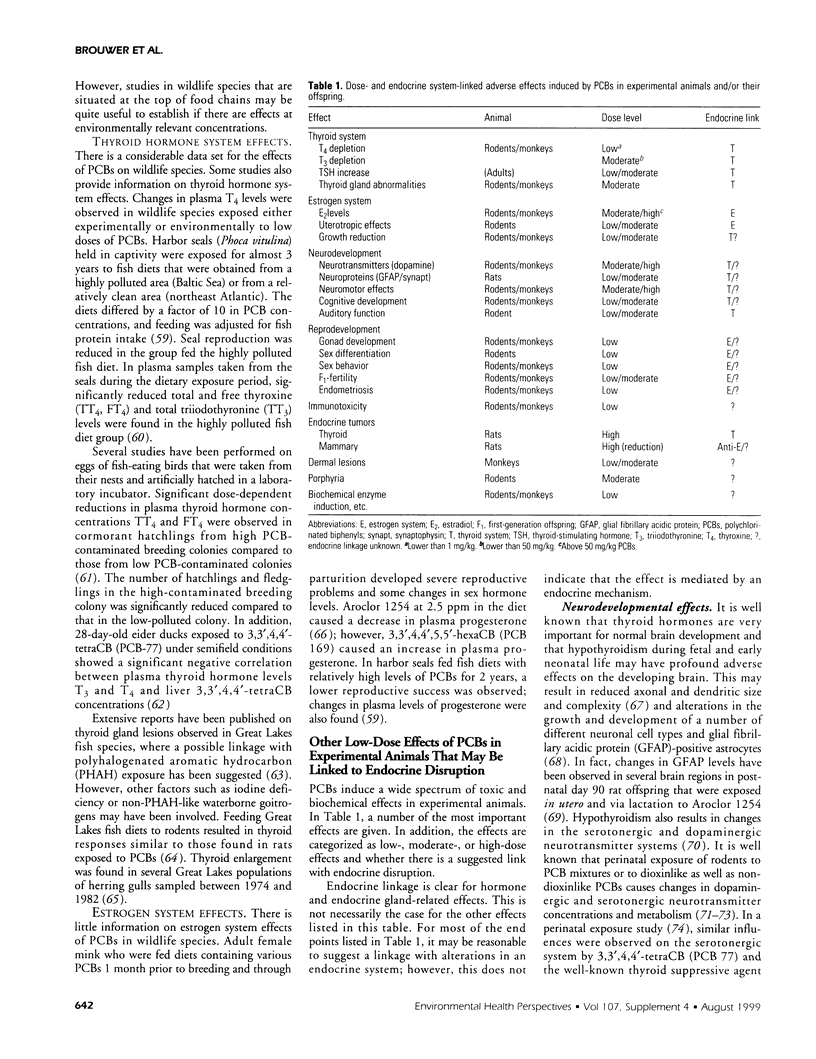
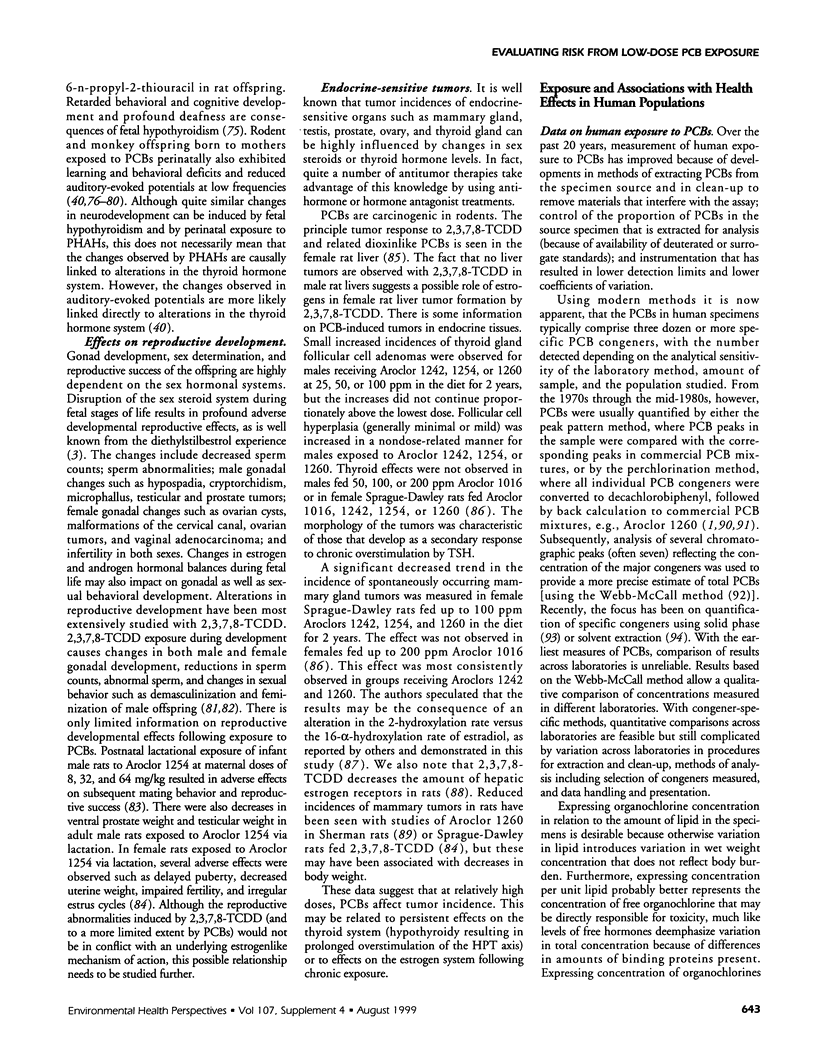
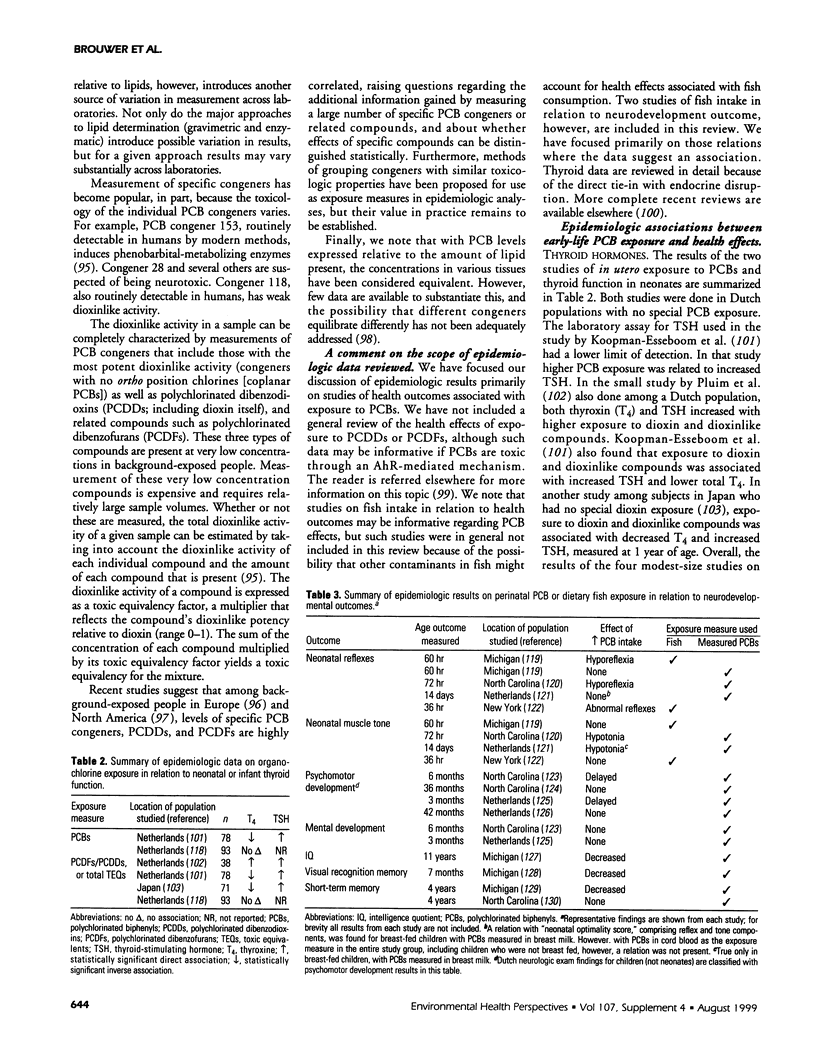
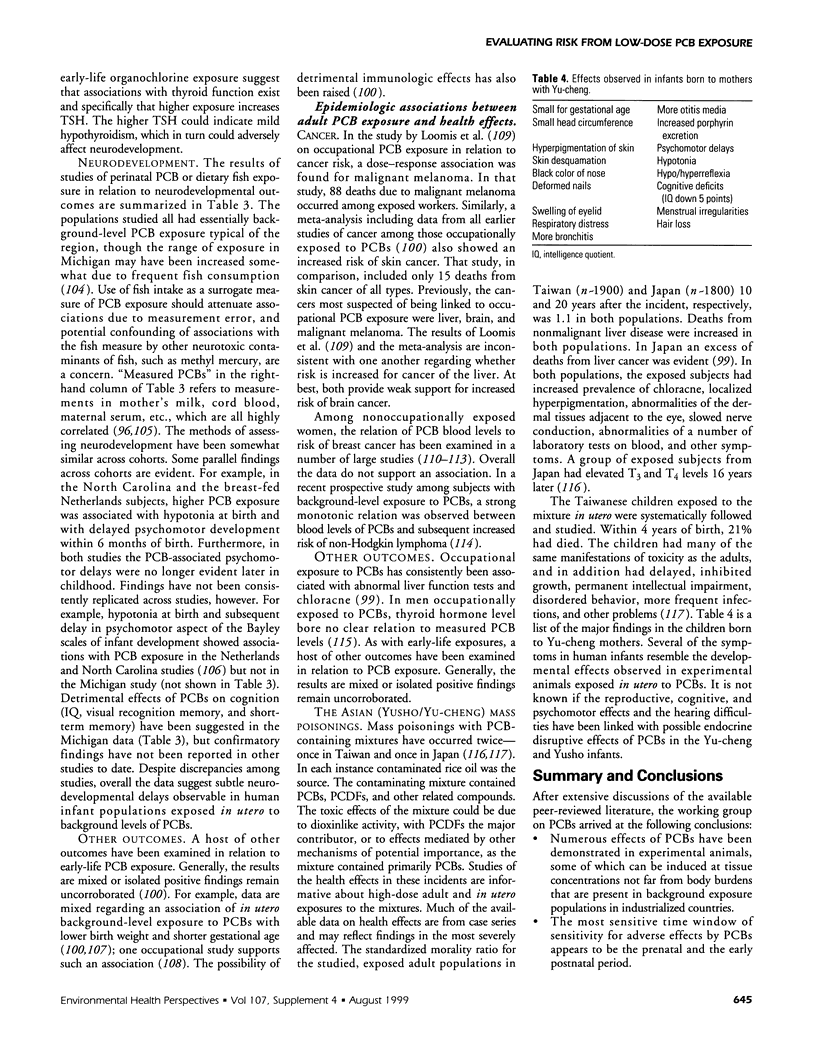
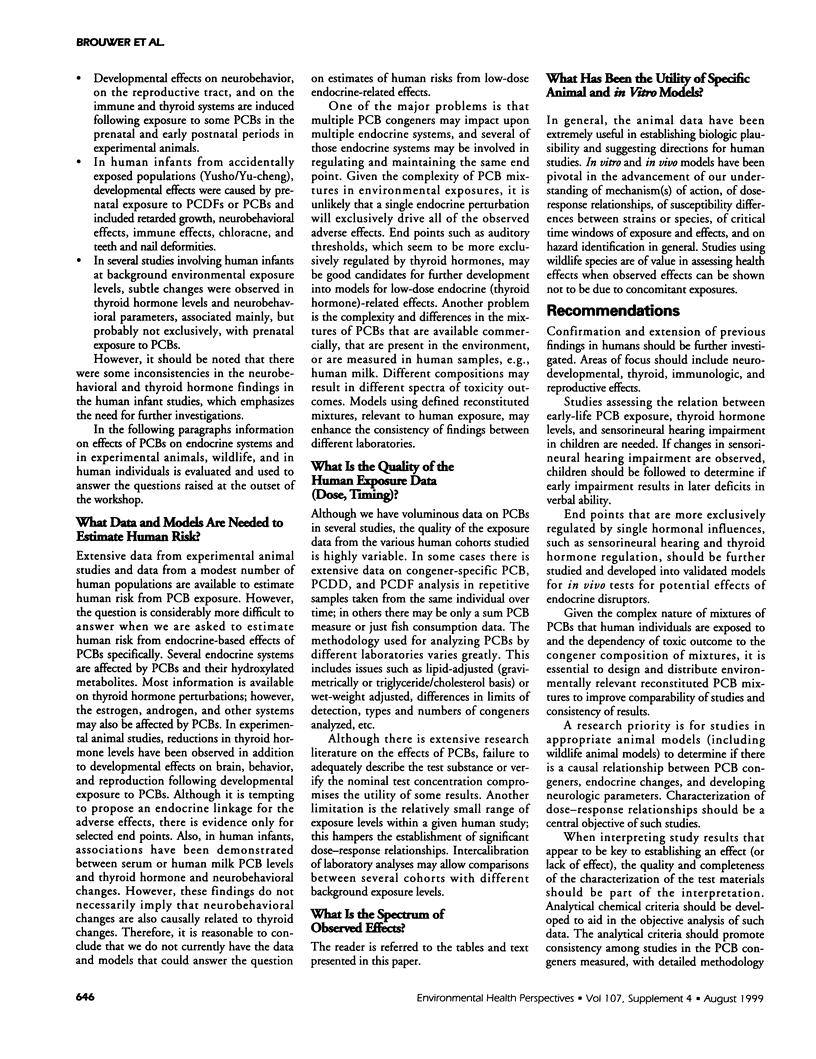
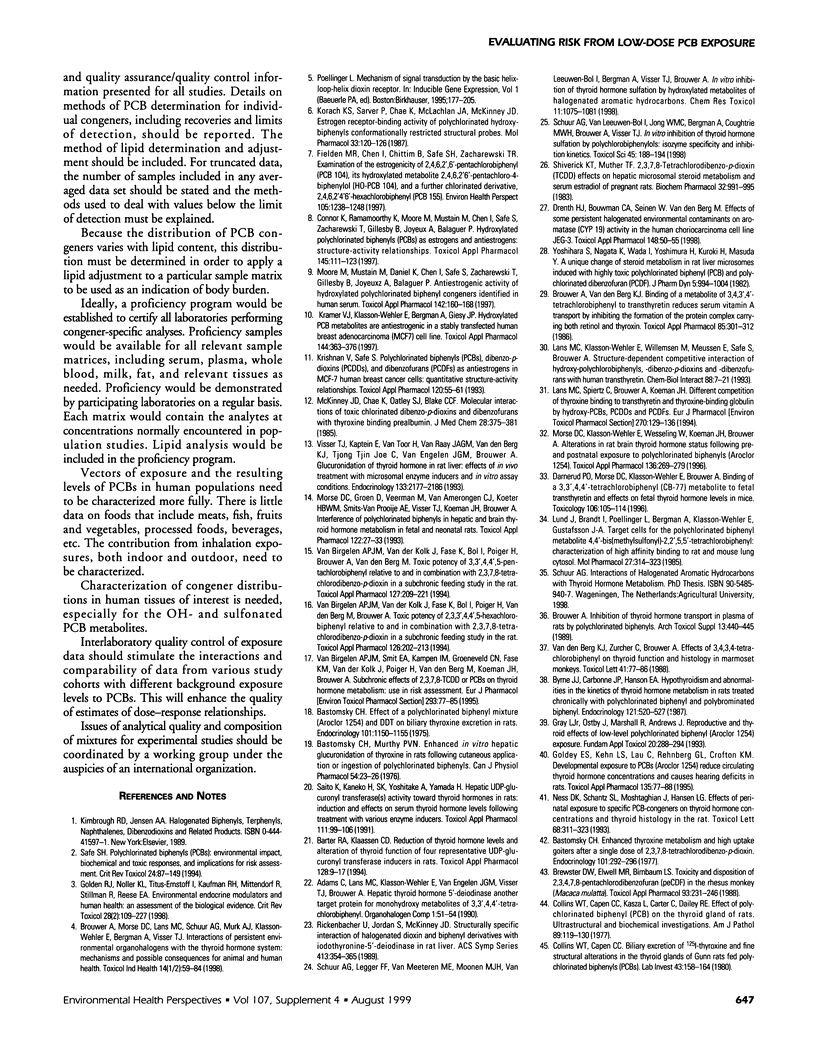
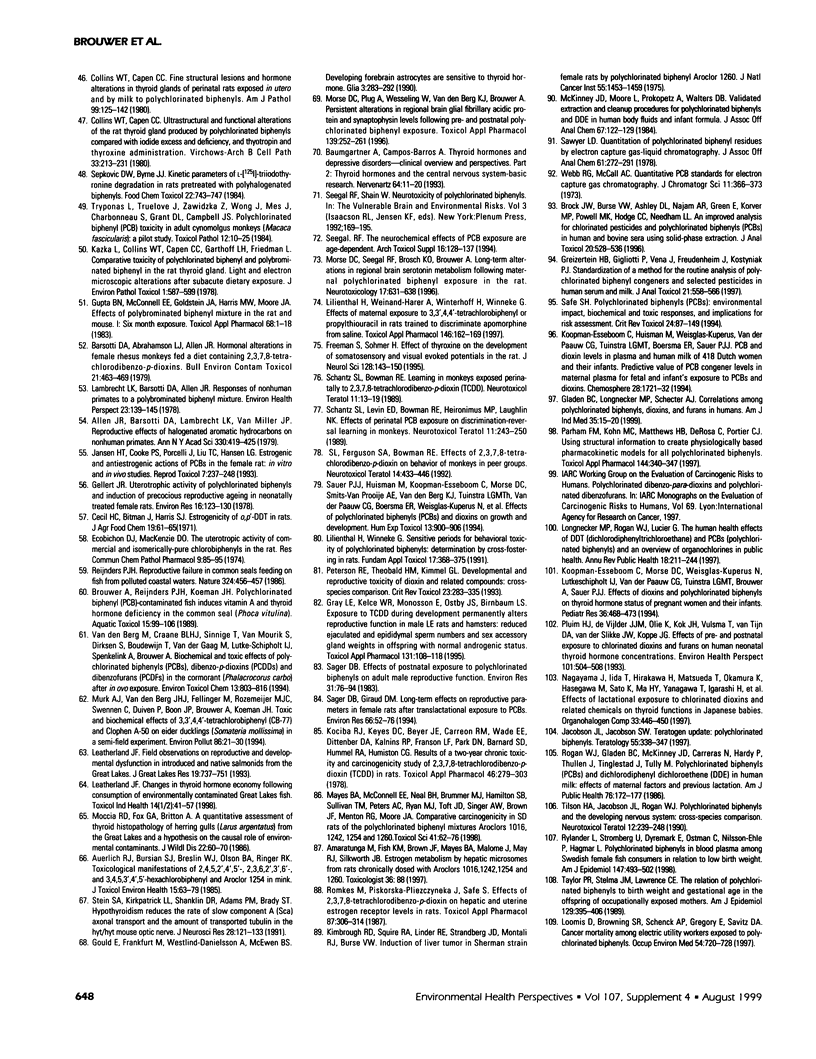
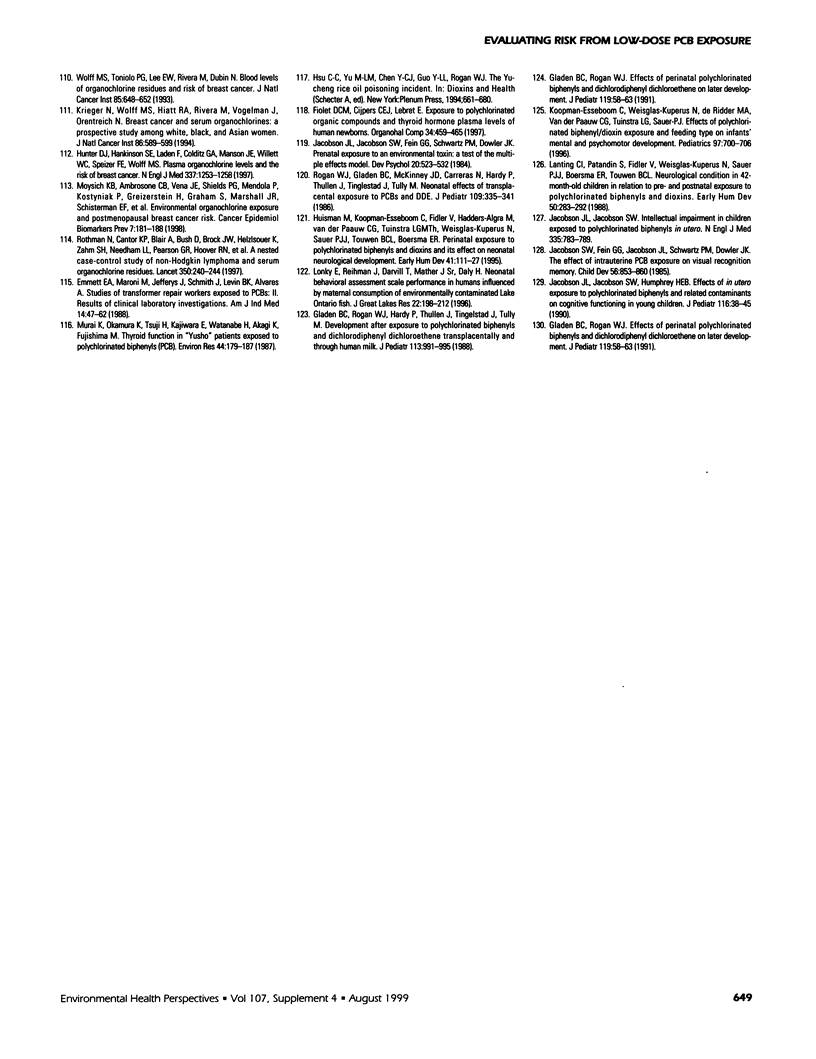
Selected References
These references are in PubMed. This may not be the complete list of references from this article.
- Allen J. R., Barsotti D. A., Lambrecht L. K., Van Miller J. P. Reproductive effects of halogenated aromatic hydrocarbons on nonhuman primates. Ann N Y Acad Sci. 1979 May 31;320:419–425. doi: 10.1111/j.1749-6632.1979.tb56623.x. [DOI] [PubMed] [Google Scholar]
- Aulerich R. J., Bursian S. J., Breslin W. J., Olson B. A., Ringer R. K. Toxicological manifestations of 2,4,5,2',4',5'-, 2,3,6,2',3',6'-, and 3,4,5,3',4',5'-hexachlorobiphenyl and Aroclor 1254 in mink. J Toxicol Environ Health. 1985;15(1):63–79. doi: 10.1080/15287398509530636. [DOI] [PubMed] [Google Scholar]
- Barsotti D. A., Abrahamson L. J., Allen J. R. Hormonal alterations in female rhesus monkeys fed a diet containing 2, 3,7,8-tetrachlorodibenzo-p-dioxin. Bull Environ Contam Toxicol. 1979 Mar;21(4-5):463–469. doi: 10.1007/BF01685454. [DOI] [PubMed] [Google Scholar]
- Barter R. A., Klaassen C. D. Reduction of thyroid hormone levels and alteration of thyroid function by four representative UDP-glucuronosyltransferase inducers in rats. Toxicol Appl Pharmacol. 1994 Sep;128(1):9–17. doi: 10.1006/taap.1994.1174. [DOI] [PubMed] [Google Scholar]
- Bastomsky C. H. Enhanced thyroxine metabolism and high uptake goiters in rats after a single dose of 2,3,7,8-tetrachlorodibenzo-p-dioxin. Endocrinology. 1977 Jul;101(1):292–296. doi: 10.1210/endo-101-1-292. [DOI] [PubMed] [Google Scholar]
- Bastomsky C. H., Murthy P. V. Enchanced in vitro hepatic glucuronidation of thyroxine in rats following cutaneous application or ingestion of polychlorinated biphenyls. Can J Physiol Pharmacol. 1976 Feb;54(1):23–26. doi: 10.1139/y76-004. [DOI] [PubMed] [Google Scholar]
- Brewster D. W., Elwell M. R., Birnbaum L. S. Toxicity and disposition of 2,3,4,7,8-pentachlorodibenzofuran (4PeCDF) in the rhesus monkey (Macaca mulatta). Toxicol Appl Pharmacol. 1988 Apr;93(2):231–246. doi: 10.1016/0041-008x(88)90123-8. [DOI] [PubMed] [Google Scholar]
- Brock J. W., Burse V. W., Ashley D. L., Najam A. R., Green V. E., Korver M. P., Powell M. K., Hodge C. C., Needham L. L. An improved analysis for chlorinated pesticides and polychlorinated biphenyls (PCBs) in human and bovine sera using solid-phase extraction. J Anal Toxicol. 1996 Nov-Dec;20(7):528–536. doi: 10.1093/jat/20.7.528. [DOI] [PubMed] [Google Scholar]
- Brouwer A. Inhibition of thyroid hormone transport in plasma of rats by polychlorinated biphenyls. Arch Toxicol Suppl. 1989;13:440–445. doi: 10.1007/978-3-642-74117-3_87. [DOI] [PubMed] [Google Scholar]
- Brouwer A., Morse D. C., Lans M. C., Schuur A. G., Murk A. J., Klasson-Wehler E., Bergman A., Visser T. J. Interactions of persistent environmental organohalogens with the thyroid hormone system: mechanisms and possible consequences for animal and human health. Toxicol Ind Health. 1998 Jan-Apr;14(1-2):59–84. doi: 10.1177/074823379801400107. [DOI] [PubMed] [Google Scholar]
- Brouwer A., van den Berg K. J. Binding of a metabolite of 3,4,3',4'-tetrachlorobiphenyl to transthyretin reduces serum vitamin A transport by inhibiting the formation of the protein complex carrying both retinol and thyroxin. Toxicol Appl Pharmacol. 1986 Sep 30;85(3):301–312. doi: 10.1016/0041-008x(86)90337-6. [DOI] [PubMed] [Google Scholar]
- Byrne J. J., Carbone J. P., Hanson E. A. Hypothyroidism and abnormalities in the kinetics of thyroid hormone metabolism in rats treated chronically with polychlorinated biphenyl and polybrominated biphenyl. Endocrinology. 1987 Aug;121(2):520–527. doi: 10.1210/endo-121-2-520. [DOI] [PubMed] [Google Scholar]
- Cecil H. C., Bitman J., Harris S. J. Estrogenicity of o,p'-DDT in rats. J Agric Food Chem. 1971 Jan-Feb;19(1):61–65. doi: 10.1021/jf60173a049. [DOI] [PubMed] [Google Scholar]
- Collins W. T., Capen C. C. Ultrastructural and functional alterations of the rat thyroid gland produced by polychlorinated biphenyls compared with iodide excess and deficiency, and thyrotropin and thyroxine administration. Virchows Arch B Cell Pathol Incl Mol Pathol. 1980;33(3):213–231. doi: 10.1007/BF02899183. [DOI] [PubMed] [Google Scholar]
- Collins W. T., Jr, Capen C. C. Biliary excretion of 125I-thyroxine and fine structural alterations in the thyroid glands of Gunn rats fed polychlorinated biphenyls (PCB). Lab Invest. 1980 Aug;43(2):158–164. [PubMed] [Google Scholar]
- Collins W. T., Jr, Capen C. C. Fine structural lesions and hormonal alterations in thyroid glands of perinatal rats exposed in utero and by the milk to polychlorinated biphenyls. Am J Pathol. 1980 Apr;99(1):125–142. [PMC free article] [PubMed] [Google Scholar]
- Collins W. T., Jr, Capen C. C., Kasza L., Carter C., Dailey R. E. Effect of polychlorinated biphenyl (PCB) on the thyroid gland of rats. Ultrastructural and biochemical investigations. Am J Pathol. 1977 Oct;89(1):119–136. [PMC free article] [PubMed] [Google Scholar]
- Connor K., Ramamoorthy K., Moore M., Mustain M., Chen I., Safe S., Zacharewski T., Gillesby B., Joyeux A., Balaguer P. Hydroxylated polychlorinated biphenyls (PCBs) as estrogens and antiestrogens: structure-activity relationships. Toxicol Appl Pharmacol. 1997 Jul;145(1):111–123. doi: 10.1006/taap.1997.8169. [DOI] [PubMed] [Google Scholar]
- Darnerud P. O., Morse D., Klasson-Wehler E., Brouwer A. Binding of a 3,3', 4,4'-tetrachlorobiphenyl (CB-77) metabolite to fetal transthyretin and effects on fetal thyroid hormone levels in mice. Toxicology. 1996 Jan 8;106(1-3):105–114. doi: 10.1016/0300-483x(95)03169-g. [DOI] [PubMed] [Google Scholar]
- Drenth H. J., Bouwman C. A., Seinen W., Van den Berg M. Effects of some persistent halogenated environmental contaminants on aromatase (CYP19) activity in the human choriocarcinoma cell line JEG-3. Toxicol Appl Pharmacol. 1998 Jan;148(1):50–55. doi: 10.1006/taap.1997.8307. [DOI] [PubMed] [Google Scholar]
- Ecobichon D. J., MacKenzie D. O. The uterotropic activity of commercial and isomerically-pure chlorobiphenyls in the rat. Res Commun Chem Pathol Pharmacol. 1974 Sep;9(1):85–95. [PubMed] [Google Scholar]
- Emmett E. A., Maroni M., Jefferys J., Schmith J., Levin B. K., Alvares A. Studies of transformer repair workers exposed to PCBs: II. Results of clinical laboratory investigations. Am J Ind Med. 1988;14(1):47–62. doi: 10.1002/ajim.4700140107. [DOI] [PubMed] [Google Scholar]
- Fielden M. R., Chen I., Chittim B., Safe S. H., Zacharewski T. R. Examination of the estrogenicity of 2,4,6,2',6'-pentachlorobiphenyl (PCB 104), its hydroxylated metabolite 2,4,6,2',6'-pentachloro-4-biphenylol (HO-PCB 104), and a further chlorinated derivative, 2,4,6,2',4',6'-hexachlorobiphenyl (PCB 155). Environ Health Perspect. 1997 Nov;105(11):1238–1248. doi: 10.1289/ehp.971051238. [DOI] [PMC free article] [PubMed] [Google Scholar]
- Freeman S., Sohmer H. Effect of thyroxine on the development of somatosensory and visual evoked potentials in the rat. J Neurol Sci. 1995 Feb;128(2):143–150. doi: 10.1016/0022-510x(94)00229-h. [DOI] [PubMed] [Google Scholar]
- Gellert R. J. Uterotrophic activity of polychlorinated biphenyls (PCB) and induction of precocious reproductive aging in neonatally treated female rats. Environ Res. 1978 Jul;16(1-3):123–130. doi: 10.1016/0013-9351(78)90149-4. [DOI] [PubMed] [Google Scholar]
- Gladen B. C., Longnecker M. P., Schecter A. J. Correlations among polychlorinated biphenyls, dioxins, and furans in humans. Am J Ind Med. 1999 Jan;35(1):15–20. doi: 10.1002/(sici)1097-0274(199901)35:1<15::aid-ajim3>3.0.co;2-z. [DOI] [PubMed] [Google Scholar]
- Gladen B. C., Rogan W. J. Effects of perinatal polychlorinated biphenyls and dichlorodiphenyl dichloroethene on later development. J Pediatr. 1991 Jul;119(1 Pt 1):58–63. doi: 10.1016/s0022-3476(05)81039-x. [DOI] [PubMed] [Google Scholar]
- Gladen B. C., Rogan W. J. Effects of perinatal polychlorinated biphenyls and dichlorodiphenyl dichloroethene on later development. J Pediatr. 1991 Jul;119(1 Pt 1):58–63. doi: 10.1016/s0022-3476(05)81039-x. [DOI] [PubMed] [Google Scholar]
- Gladen B. C., Rogan W. J., Hardy P., Thullen J., Tingelstad J., Tully M. Development after exposure to polychlorinated biphenyls and dichlorodiphenyl dichloroethene transplacentally and through human milk. J Pediatr. 1988 Dec;113(6):991–995. doi: 10.1016/s0022-3476(88)80569-9. [DOI] [PubMed] [Google Scholar]
- Golden R. J., Noller K. L., Titus-Ernstoff L., Kaufman R. H., Mittendorf R., Stillman R., Reese E. A. Environmental endocrine modulators and human health: an assessment of the biological evidence. Crit Rev Toxicol. 1998 Mar;28(2):109–227. doi: 10.1080/10408449891344191. [DOI] [PubMed] [Google Scholar]
- Gould E., Frankfurt M., Westlind-Danielsson A., McEwen B. S. Developing forebrain astrocytes are sensitive to thyroid hormone. Glia. 1990;3(4):283–292. doi: 10.1002/glia.440030408. [DOI] [PubMed] [Google Scholar]
- Gray L. E., Jr, Kelce W. R., Monosson E., Ostby J. S., Birnbaum L. S. Exposure to TCDD during development permanently alters reproductive function in male Long Evans rats and hamsters: reduced ejaculated and epididymal sperm numbers and sex accessory gland weights in offspring with normal androgenic status. Toxicol Appl Pharmacol. 1995 Mar;131(1):108–118. doi: 10.1006/taap.1995.1052. [DOI] [PubMed] [Google Scholar]
- Gray L. E., Jr, Ostby J., Marshall R., Andrews J. Reproductive and thyroid effects of low-level polychlorinated biphenyl (Aroclor 1254) exposure. Fundam Appl Toxicol. 1993 Apr;20(3):288–294. doi: 10.1006/faat.1993.1038. [DOI] [PubMed] [Google Scholar]
- Greizerstein H. B., Gigliotti P., Vena J., Freudenheim J., Kostyniak P. J. Standardization of a method for the routine analysis of polychlorinated biphenyl congeners and selected pesticides in human serum and milk. J Anal Toxicol. 1997 Nov-Dec;21(7):558–566. doi: 10.1093/jat/21.7.558. [DOI] [PubMed] [Google Scholar]
- Gupta B. N., McConnell E. E., Goldstein J. A., Harris M. W., Moore J. A. Effects of a polybrominated biphenyl mixture in the rat and mouse. I. Six-month exposure. Toxicol Appl Pharmacol. 1983 Mar 30;68(1):1–18. doi: 10.1016/0041-008x(83)90350-2. [DOI] [PubMed] [Google Scholar]
- Huisman M., Koopman-Esseboom C., Fidler V., Hadders-Algra M., van der Paauw C. G., Tuinstra L. G., Weisglas-Kuperus N., Sauer P. J., Touwen B. C., Boersma E. R. Perinatal exposure to polychlorinated biphenyls and dioxins and its effect on neonatal neurological development. Early Hum Dev. 1995 Apr 14;41(2):111–127. doi: 10.1016/0378-3782(94)01611-r. [DOI] [PubMed] [Google Scholar]
- Hunter D. J., Hankinson S. E., Laden F., Colditz G. A., Manson J. E., Willett W. C., Speizer F. E., Wolff M. S. Plasma organochlorine levels and the risk of breast cancer. N Engl J Med. 1997 Oct 30;337(18):1253–1258. doi: 10.1056/NEJM199710303371801. [DOI] [PubMed] [Google Scholar]
- Jacobson J. L., Jacobson S. W., Humphrey H. E. Effects of in utero exposure to polychlorinated biphenyls and related contaminants on cognitive functioning in young children. J Pediatr. 1990 Jan;116(1):38–45. doi: 10.1016/s0022-3476(05)81642-7. [DOI] [PubMed] [Google Scholar]
- Jacobson J. L., Jacobson S. W. Intellectual impairment in children exposed to polychlorinated biphenyls in utero. N Engl J Med. 1996 Sep 12;335(11):783–789. doi: 10.1056/NEJM199609123351104. [DOI] [PubMed] [Google Scholar]
- Jacobson J. L., Jacobson S. W. Teratogen update: polychlorinated biphenyls. Teratology. 1997 May;55(5):338–347. doi: 10.1002/(SICI)1096-9926(199705)55:5<338::AID-TERA6>3.0.CO;2-V. [DOI] [PubMed] [Google Scholar]
- Jacobson S. W., Fein G. G., Jacobson J. L., Schwartz P. M., Dowler J. K. The effect of intrauterine PCB exposure on visual recognition memory. Child Dev. 1985 Aug;56(4):853–860. [PubMed] [Google Scholar]
- Jansen H. T., Cooke P. S., Porcelli J., Liu T. C., Hansen L. G. Estrogenic and antiestrogenic actions of PCBs in the female rat: in vitro and in vivo studies. Reprod Toxicol. 1993 May-Jun;7(3):237–248. doi: 10.1016/0890-6238(93)90230-5. [DOI] [PubMed] [Google Scholar]
- Kasza L., Collins W. T., Capen C. C., Garthoff L. H., Friedman L. Comparative toxicity of polychlorinated biphenyl and polybrominated biphenylin the rat thyroid gland: light and electron microscopic alterations after subacute dietary exposure. J Environ Pathol Toxicol. 1978 May-Jun;1(5):587–599. [PubMed] [Google Scholar]
- Kimbrough R. D., Squire R. A., Linder R. E., Strandberg J. D., Montalli R. J., Burse V. W. Induction of liver tumor in Sherman strain female rats by polychlorinated biphenyl aroclor 1260. J Natl Cancer Inst. 1975 Dec;55(6):1453–1459. doi: 10.1093/jnci/55.6.1453. [DOI] [PubMed] [Google Scholar]
- Kociba R. J., Keyes D. G., Beyer J. E., Carreon R. M., Wade C. E., Dittenber D. A., Kalnins R. P., Frauson L. E., Park C. N., Barnard S. D. Results of a two-year chronic toxicity and oncogenicity study of 2,3,7,8-tetrachlorodibenzo-p-dioxin in rats. Toxicol Appl Pharmacol. 1978 Nov;46(2):279–303. doi: 10.1016/0041-008x(78)90075-3. [DOI] [PubMed] [Google Scholar]
- Koopman-Esseboom C., Morse D. C., Weisglas-Kuperus N., Lutkeschipholt I. J., Van der Paauw C. G., Tuinstra L. G., Brouwer A., Sauer P. J. Effects of dioxins and polychlorinated biphenyls on thyroid hormone status of pregnant women and their infants. Pediatr Res. 1994 Oct;36(4):468–473. doi: 10.1203/00006450-199410000-00009. [DOI] [PubMed] [Google Scholar]
- Koopman-Esseboom C., Weisglas-Kuperus N., de Ridder M. A., Van der Paauw C. G., Tuinstra L. G., Sauer P. J. Effects of polychlorinated biphenyl/dioxin exposure and feeding type on infants' mental and psychomotor development. Pediatrics. 1996 May;97(5):700–706. [PubMed] [Google Scholar]
- Korach K. S., Sarver P., Chae K., McLachlan J. A., McKinney J. D. Estrogen receptor-binding activity of polychlorinated hydroxybiphenyls: conformationally restricted structural probes. Mol Pharmacol. 1988 Jan;33(1):120–126. [PubMed] [Google Scholar]
- Kramer V. J., Helferich W. G., Bergman A., Klasson-Wehler E., Giesy J. P. Hydroxylated polychlorinated biphenyl metabolites are anti-estrogenic in a stably transfected human breast adenocarcinoma (MCF7) cell line. Toxicol Appl Pharmacol. 1997 Jun;144(2):363–376. doi: 10.1006/taap.1997.8163. [DOI] [PubMed] [Google Scholar]
- Krieger N., Wolff M. S., Hiatt R. A., Rivera M., Vogelman J., Orentreich N. Breast cancer and serum organochlorines: a prospective study among white, black, and Asian women. J Natl Cancer Inst. 1994 Apr 20;86(8):589–599. doi: 10.1093/jnci/86.8.589. [DOI] [PubMed] [Google Scholar]
- Krishnan V., Safe S. Polychlorinated biphenyls (PCBs), dibenzo-p-dioxins (PCDDs), and dibenzofurans (PCDFs) as antiestrogens in MCF-7 human breast cancer cells: quantitative structure-activity relationships. Toxicol Appl Pharmacol. 1993 May;120(1):55–61. doi: 10.1006/taap.1993.1086. [DOI] [PubMed] [Google Scholar]
- Lambrecht L. K., Barsotti D. A., Allen J. R. Responses of nonhuman primates to a polybrominated biphenyl mixture. Environ Health Perspect. 1978 Apr;23:139–145. doi: 10.1289/ehp.7823139. [DOI] [PMC free article] [PubMed] [Google Scholar]
- Lans M. C., Klasson-Wehler E., Willemsen M., Meussen E., Safe S., Brouwer A. Structure-dependent, competitive interaction of hydroxy-polychlorobiphenyls, -dibenzo-p-dioxins and -dibenzofurans with human transthyretin. Chem Biol Interact. 1993 Jul;88(1):7–21. doi: 10.1016/0009-2797(93)90081-9. [DOI] [PubMed] [Google Scholar]
- Lans M. C., Spiertz C., Brouwer A., Koeman J. H. Different competition of thyroxine binding to transthyretin and thyroxine-binding globulin by hydroxy-PCBs, PCDDs and PCDFs. Eur J Pharmacol. 1994 Apr 4;270(2-3):129–136. doi: 10.1016/0926-6917(94)90054-x. [DOI] [PubMed] [Google Scholar]
- Lanting C. I., Patandin S., Fidler V., Weisglas-Kuperus N., Sauer P. J., Boersma E. R., Touwen B. C. Neurological condition in 42-month-old children in relation to pre- and postnatal exposure to polychlorinated biphenyls and dioxins. Early Hum Dev. 1998 Feb 27;50(3):283–292. doi: 10.1016/s0378-3782(97)00066-2. [DOI] [PubMed] [Google Scholar]
- Leatherland J. F. Changes in thyroid hormone economy following consumption of environmentally contaminated Great Lakes fish. Toxicol Ind Health. 1998 Jan-Apr;14(1-2):41–57. doi: 10.1177/074823379801400106. [DOI] [PubMed] [Google Scholar]
- Lilienthal H., Weinand-Härer A., Winterhoff H., Winneke G. Effects of maternal exposure to 3,3',4,4'-tetrachlorobiphenyl or propylthiouracil in rats trained to discriminate apomorphine from saline. Toxicol Appl Pharmacol. 1997 Sep;146(1):162–169. doi: 10.1006/taap.1997.8245. [DOI] [PubMed] [Google Scholar]
- Lilienthal H., Winneke G. Sensitive periods for behavioral toxicity of polychlorinated biphenyls: determination by cross-fostering in rats. Fundam Appl Toxicol. 1991 Aug;17(2):368–375. doi: 10.1016/0272-0590(91)90226-t. [DOI] [PubMed] [Google Scholar]
- Longnecker M. P., Rogan W. J., Lucier G. The human health effects of DDT (dichlorodiphenyltrichloroethane) and PCBS (polychlorinated biphenyls) and an overview of organochlorines in public health. Annu Rev Public Health. 1997;18:211–244. doi: 10.1146/annurev.publhealth.18.1.211. [DOI] [PubMed] [Google Scholar]
- Loomis D., Browning S. R., Schenck A. P., Gregory E., Savitz D. A. Cancer mortality among electric utility workers exposed to polychlorinated biphenyls. Occup Environ Med. 1997 Oct;54(10):720–728. doi: 10.1136/oem.54.10.720. [DOI] [PMC free article] [PubMed] [Google Scholar]
- Lund J., Brandt I., Poellinger L., Bergman A., Klasson-Wehler E., Gustafsson J. A. Target cells for the polychlorinated biphenyl metabolite 4,4'-bis(methylsulfonyl)-2,2',5,5'-tetrachlorobiphenyl. Characterization of high affinity binding in rat and mouse lung cytosol. Mol Pharmacol. 1985 Feb;27(2):314–323. [PubMed] [Google Scholar]
- Mayes B. A., McConnell E. E., Neal B. H., Brunner M. J., Hamilton S. B., Sullivan T. M., Peters A. C., Ryan M. J., Toft J. D., Singer A. W. Comparative carcinogenicity in Sprague-Dawley rats of the polychlorinated biphenyl mixtures Aroclors 1016, 1242, 1254, and 1260. Toxicol Sci. 1998 Jan;41(1):62–76. doi: 10.1093/toxsci/41.1.62. [DOI] [PMC free article] [PubMed] [Google Scholar]
- McKinney J. D., Chae K., Oatley S. J., Blake C. C. Molecular interactions of toxic chlorinated dibenzo-p-dioxins and dibenzofurans with thyroxine binding prealbumin. J Med Chem. 1985 Mar;28(3):375–381. doi: 10.1021/jm00381a018. [DOI] [PubMed] [Google Scholar]
- McKinney J. D., Moore L., Prokopetz A., Walters D. B. Validated extraction and cleanup procedures for polychlorinated biphenyls and DDE in human body fluids and infant formula. J Assoc Off Anal Chem. 1984 Jan-Feb;67(1):122–129. [PubMed] [Google Scholar]
- Moccia R. D., Fox G. A., Britton A. A quantitative assessment of thyroid histopathology of herring gulls (Larus argentatus) from the Great Lakes and a hypothesis on the causal role of environmental contaminants. J Wildl Dis. 1986 Jan;22(1):60–70. doi: 10.7589/0090-3558-22.1.60. [DOI] [PubMed] [Google Scholar]
- Moore M., Mustain M., Daniel K., Chen I., Safe S., Zacharewski T., Gillesby B., Joyeux A., Balaguer P. Antiestrogenic activity of hydroxylated polychlorinated biphenyl congeners identified in human serum. Toxicol Appl Pharmacol. 1997 Jan;142(1):160–168. doi: 10.1006/taap.1996.8022. [DOI] [PubMed] [Google Scholar]
- Morse D. C., Groen D., Veerman M., van Amerongen C. J., Koëter H. B., Smits van Prooije A. E., Visser T. J., Koeman J. H., Brouwer A. Interference of polychlorinated biphenyls in hepatic and brain thyroid hormone metabolism in fetal and neonatal rats. Toxicol Appl Pharmacol. 1993 Sep;122(1):27–33. doi: 10.1006/taap.1993.1168. [DOI] [PubMed] [Google Scholar]
- Morse D. C., Plug A., Wesseling W., van den Berg K. J., Brouwer A. Persistent alterations in regional brain glial fibrillary acidic protein and synaptophysin levels following pre- and postnatal polychlorinated biphenyl exposure. Toxicol Appl Pharmacol. 1996 Aug;139(2):252–261. doi: 10.1006/taap.1996.0164. [DOI] [PubMed] [Google Scholar]
- Morse D. C., Seegal R. F., Borsch K. O., Brouwer A. Long-term alterations in regional brain serotonin metabolism following maternal polychlorinated biphenyl exposure in the rat. Neurotoxicology. 1996 Fall-Winter;17(3-4):631–638. [PubMed] [Google Scholar]
- Morse D. C., Wehler E. K., Wesseling W., Koeman J. H., Brouwer A. Alterations in rat brain thyroid hormone status following pre- and postnatal exposure to polychlorinated biphenyls (Aroclor 1254). Toxicol Appl Pharmacol. 1996 Feb;136(2):269–279. doi: 10.1006/taap.1996.0034. [DOI] [PubMed] [Google Scholar]
- Moysich K. B., Ambrosone C. B., Vena J. E., Shields P. G., Mendola P., Kostyniak P., Greizerstein H., Graham S., Marshall J. R., Schisterman E. F. Environmental organochlorine exposure and postmenopausal breast cancer risk. Cancer Epidemiol Biomarkers Prev. 1998 Mar;7(3):181–188. [PubMed] [Google Scholar]
- Murai K., Okamura K., Tsuji H., Kajiwara E., Watanabe H., Akagi K., Fujishima M. Thyroid function in "yusho" patients exposed to polychlorinated biphenyls (PCB). Environ Res. 1987 Dec;44(2):179–187. doi: 10.1016/s0013-9351(87)80226-8. [DOI] [PubMed] [Google Scholar]
- Murk A. J., Van den Berg J. H., Fellinger M., Rozemeijer M. J., Swennen C., Duiven P., Boon J. P., Brouwer A., Koeman J. H. Toxic and biochemical effects of 3,3',4,4'-tetrachlorobiphenyl (CB-77) and clophen A50 on eider duckling (Somateria mollissima) in a semi-field experiment. Environ Pollut. 1994;86(1):21–30. doi: 10.1016/0269-7491(94)90005-1. [DOI] [PubMed] [Google Scholar]
- Ness D. K., Schantz S. L., Moshtaghian J., Hansen L. G. Effects of perinatal exposure to specific PCB congeners on thyroid hormone concentrations and thyroid histology in the rat. Toxicol Lett. 1993 Jun;68(3):311–323. doi: 10.1016/0378-4274(93)90023-q. [DOI] [PubMed] [Google Scholar]
- Parham F. M., Kohn M. C., Matthews H. B., DeRosa C., Portier C. J. Using structural information to create physiologically based pharmacokinetic models for all polychlorinated biphenyls. Toxicol Appl Pharmacol. 1997 Jun;144(2):340–347. doi: 10.1006/taap.1997.8139. [DOI] [PubMed] [Google Scholar]
- Peterson R. E., Theobald H. M., Kimmel G. L. Developmental and reproductive toxicity of dioxins and related compounds: cross-species comparisons. Crit Rev Toxicol. 1993;23(3):283–335. doi: 10.3109/10408449309105013. [DOI] [PubMed] [Google Scholar]
- Pluim H. J., de Vijlder J. J., Olie K., Kok J. H., Vulsma T., van Tijn D. A., van der Slikke J. W., Koppe J. G. Effects of pre- and postnatal exposure to chlorinated dioxins and furans on human neonatal thyroid hormone concentrations. Environ Health Perspect. 1993 Nov;101(6):504–508. doi: 10.1289/ehp.93101504. [DOI] [PMC free article] [PubMed] [Google Scholar]
- Reijnders P. J. Reproductive failure in common seals feeding on fish from polluted coastal waters. Nature. 1986 Dec 4;324(6096):456–457. doi: 10.1038/324456a0. [DOI] [PubMed] [Google Scholar]
- Rogan W. J., Gladen B. C., McKinney J. D., Carreras N., Hardy P., Thullen J., Tingelstad J., Tully M. Polychlorinated biphenyls (PCBs) and dichlorodiphenyl dichloroethene (DDE) in human milk: effects of maternal factors and previous lactation. Am J Public Health. 1986 Feb;76(2):172–177. doi: 10.2105/ajph.76.2.172. [DOI] [PMC free article] [PubMed] [Google Scholar]
- Rogan W. J., Gladen B. C., McKinney J. D., Carreras N., Hardy P., Thullen J., Tinglestad J., Tully M. Neonatal effects of transplacental exposure to PCBs and DDE. J Pediatr. 1986 Aug;109(2):335–341. doi: 10.1016/s0022-3476(86)80397-3. [DOI] [PubMed] [Google Scholar]
- Romkes M., Piskorska-Pliszczynska J., Safe S. Effects of 2,3,7,8-tetrachlorodibenzo-p-dioxin on hepatic and uterine estrogen receptor levels in rats. Toxicol Appl Pharmacol. 1987 Feb;87(2):306–314. doi: 10.1016/0041-008x(87)90292-4. [DOI] [PubMed] [Google Scholar]
- Rothman N., Cantor K. P., Blair A., Bush D., Brock J. W., Helzlsouer K., Zahm S. H., Needham L. L., Pearson G. R., Hoover R. N. A nested case-control study of non-Hodgkin lymphoma and serum organochlorine residues. Lancet. 1997 Jul 26;350(9073):240–244. doi: 10.1016/S0140-6736(97)02088-6. [DOI] [PubMed] [Google Scholar]
- Rylander L., Strömberg U., Dyremark E., Ostman C., Nilsson-Ehle P., Hagmar L. Polychlorinated biphenyls in blood plasma among Swedish female fish consumers in relation to low birth weight. Am J Epidemiol. 1998 Mar 1;147(5):493–502. doi: 10.1093/oxfordjournals.aje.a009476. [DOI] [PubMed] [Google Scholar]
- Safe S. H. Polychlorinated biphenyls (PCBs): environmental impact, biochemical and toxic responses, and implications for risk assessment. Crit Rev Toxicol. 1994;24(2):87–149. doi: 10.3109/10408449409049308. [DOI] [PubMed] [Google Scholar]
- Safe S. H. Polychlorinated biphenyls (PCBs): environmental impact, biochemical and toxic responses, and implications for risk assessment. Crit Rev Toxicol. 1994;24(2):87–149. doi: 10.3109/10408449409049308. [DOI] [PubMed] [Google Scholar]
- Sager D. B. Effect of postnatal exposure to polychlorinated biphenyls on adult male reproductive function. Environ Res. 1983 Jun;31(1):76–94. doi: 10.1016/0013-9351(83)90063-4. [DOI] [PubMed] [Google Scholar]
- Sager D. B., Girard D. M. Long-term effects on reproductive parameters in female rats after translactational exposure to PCBs. Environ Res. 1994 Jul;66(1):52–76. doi: 10.1006/enrs.1994.1044. [DOI] [PubMed] [Google Scholar]
- Saito K., Kaneko H., Sato K., Yoshitake A., Yamada H. Hepatic UDP-glucuronyltransferase(s) activity toward thyroid hormones in rats: induction and effects on serum thyroid hormone levels following treatment with various enzyme inducers. Toxicol Appl Pharmacol. 1991 Oct;111(1):99–106. doi: 10.1016/0041-008x(91)90138-5. [DOI] [PubMed] [Google Scholar]
- Sauer P. J., Huisman M., Koopman-Esseboom C., Morse D. C., Smits-van Prooije A. E., van de Berg K. J., Tuinstra L. G., van der Paauw C. G., Boersma E. R., Weisglas-Kuperus N. Effects of polychlorinated biphenyls (PCBs) and dioxins on growth and development. Hum Exp Toxicol. 1994 Dec;13(12):900–906. doi: 10.1177/096032719401301213. [DOI] [PubMed] [Google Scholar]
- Sawyer L. D. Quantitation of polychlorinated biphenyl residues by electron capture gas-liquid chromatography: reference material characterization and preliminary study. J Assoc Off Anal Chem. 1978 Mar;61(2):272–281. [PubMed] [Google Scholar]
- Schantz S. L., Bowman R. E. Learning in monkeys exposed perinatally to 2,3,7,8-tetrachlorodibenzo-p-dioxin (TCDD). Neurotoxicol Teratol. 1989 Jan-Feb;11(1):13–19. doi: 10.1016/0892-0362(89)90080-9. [DOI] [PubMed] [Google Scholar]
- Schantz S. L., Ferguson S. A., Bowman R. E. Effects of 2,3,7,8-tetrachlorodibenzo-p-dioxin on behavior of monkeys in peer groups. Neurotoxicol Teratol. 1992 Nov-Dec;14(6):433–446. doi: 10.1016/0892-0362(92)90054-e. [DOI] [PubMed] [Google Scholar]
- Schantz S. L., Levin E. D., Bowman R. E., Heironimus M. P., Laughlin N. K. Effects of perinatal PCB exposure on discrimination-reversal learning in monkeys. Neurotoxicol Teratol. 1989 May-Jun;11(3):243–250. doi: 10.1016/0892-0362(89)90066-4. [DOI] [PubMed] [Google Scholar]
- Schuur A. G., Legger F. F., van Meeteren M. E., Moonen M. J., van Leeuwen-Bol I., Bergman A., Visser T. J., Brouwer A. In vitro inhibition of thyroid hormone sulfation by hydroxylated metabolites of halogenated aromatic hydrocarbons. Chem Res Toxicol. 1998 Sep;11(9):1075–1081. doi: 10.1021/tx9800046. [DOI] [PubMed] [Google Scholar]
- Schuur A. G., van Leeuwen-Bol I., Jong W. M., Bergman A., Coughtrie M. W., Brouwer A., Visser T. J. In vitro inhibition of thyroid hormone sulfation by polychlorobiphenylols: isozyme specificity and inhibition kinetics. Toxicol Sci. 1998 Oct;45(2):188–194. doi: 10.1006/toxs.1998.2504. [DOI] [PubMed] [Google Scholar]
- Seegal R. F. The neurochemical effects of PCB exposure are age-dependent. Arch Toxicol Suppl. 1994;16:128–137. doi: 10.1007/978-3-642-78640-2_15. [DOI] [PubMed] [Google Scholar]
- Sepkovic D. W., Byrne J. J. Kinetic parameters of L-[125I]triiodothyronine degradation in rats pretreated with polyhalogenated biphenyls. Food Chem Toxicol. 1984 Sep;22(9):743–747. doi: 10.1016/0278-6915(84)90203-5. [DOI] [PubMed] [Google Scholar]
- Shiverick K. T., Muther T. F. 2,3,7,8-tetrachlorodibenzo-p-dioxin (TCDD) effects on hepatic microsomal steroid metabolism and serum estradiol of pregnant rats. Biochem Pharmacol. 1983 Mar 15;32(6):991–995. doi: 10.1016/0006-2952(83)90616-0. [DOI] [PubMed] [Google Scholar]
- Stein S. A., Kirkpatrick L. L., Shanklin D. R., Adams P. M., Brady S. T. Hypothyroidism reduces the rate of slow component A (SCa) axonal transport and the amount of transported tubulin in the hyt/hyt mouse optic nerve. J Neurosci Res. 1991 Jan;28(1):121–133. doi: 10.1002/jnr.490280113. [DOI] [PubMed] [Google Scholar]
- Taylor P. R., Stelma J. M., Lawrence C. E. The relation of polychlorinated biphenyls to birth weight and gestational age in the offspring of occupationally exposed mothers. Am J Epidemiol. 1989 Feb;129(2):395–406. doi: 10.1093/oxfordjournals.aje.a115143. [DOI] [PubMed] [Google Scholar]
- Tilson H. A., Jacobson J. L., Rogan W. J. Polychlorinated biphenyls and the developing nervous system: cross-species comparisons. Neurotoxicol Teratol. 1990 May-Jun;12(3):239–248. doi: 10.1016/0892-0362(90)90095-t. [DOI] [PubMed] [Google Scholar]
- Tryphonas L., Truelove J., Zawidzka Z., Wong J., Mes J., Charbonneau S., Grant D. L., Campbell J. S. Polychlorinated biphenyl (PCB) toxicity in adult cynomolgus monkeys (M. fascicularis): a pilot study. Toxicol Pathol. 1984;12(1):10–25. doi: 10.1177/019262338401200103. [DOI] [PubMed] [Google Scholar]
- Van Birgelen A. P., Smit E. A., Kampen I. M., Groeneveld C. N., Fase K. M., Van der Kolk J., Poiger H., Van den Berg M., Koeman J. H., Brouwer A. Subchronic effects of 2,3,7,8-TCDD or PCBs on thyroid hormone metabolism: use in risk assessment. Eur J Pharmacol. 1995 May 26;293(1):77–85. doi: 10.1016/0926-6917(95)90021-7. [DOI] [PubMed] [Google Scholar]
- Van Birgelen A. P., Van der Kolk J., Fase K. M., Bol I., Poiger H., Brouwer A., Van den Berg M. Toxic potency of 3,3',4,4',5-pentachlorobiphenyl relative to and in combination with 2,3,7,8-tetrachlorodibenzo-p-dioxin in a subchronic feeding study in the rat. Toxicol Appl Pharmacol. 1994 Aug;127(2):209–221. doi: 10.1006/taap.1994.1155. [DOI] [PubMed] [Google Scholar]
- Van Birgelen A. P., Van der Kolk J., Fase K. M., Bol I., Poiger H., Van den Berg M., Brouwer A. Toxic potency of 2,3,3',4,4',5-hexachlorobiphenyl relative to and in combination with 2,3,7,8-tetrachlorodibenzo-p-dioxin in a subchronic feeding study in the rat. Toxicol Appl Pharmacol. 1994 Jun;126(2):202–213. doi: 10.1006/taap.1994.1109. [DOI] [PubMed] [Google Scholar]
- Visser T. J., Kaptein E., van Toor H., van Raaij J. A., van den Berg K. J., Joe C. T., van Engelen J. G., Brouwer A. Glucuronidation of thyroid hormone in rat liver: effects of in vivo treatment with microsomal enzyme inducers and in vitro assay conditions. Endocrinology. 1993 Nov;133(5):2177–2186. doi: 10.1210/endo.133.5.8404669. [DOI] [PubMed] [Google Scholar]
- Webb R. G., McCall A. C. Quantitative PCB standards for electron capture gas chromatography. J Chromatogr Sci. 1973 Jul;11(7):366–373. doi: 10.1093/chromsci/11.7.366. [DOI] [PubMed] [Google Scholar]
- Wolff M. S., Toniolo P. G., Lee E. W., Rivera M., Dubin N. Blood levels of organochlorine residues and risk of breast cancer. J Natl Cancer Inst. 1993 Apr 21;85(8):648–652. doi: 10.1093/jnci/85.8.648. [DOI] [PubMed] [Google Scholar]
- Yoshihara S., Nagata K., Wada I., Yoshimura H., Kuroki H., Masuda Y. A unique change of steroid metabolism in rat liver microsomes induced with highly toxic polychlorinated biphenyl(PCB) and polychlorinated dibenzofuran(PCDF). J Pharmacobiodyn. 1982 Dec;5(12):994–1004. doi: 10.1248/bpb1978.5.994. [DOI] [PubMed] [Google Scholar]
- van den Berg K. J., Zurcher C., Brouwer A. Effects of 3,4,3',4'-tetrachlorobiphenyl on thyroid function and histology in marmoset monkeys. Toxicol Lett. 1988 Apr;41(1):77–86. doi: 10.1016/0378-4274(88)90010-0. [DOI] [PubMed] [Google Scholar]


